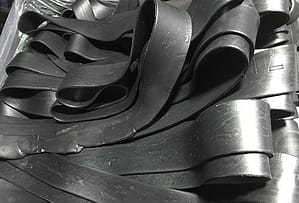 EPDM (Ethylene Propylene Diene Monomer) Rubber Compounds
EPDM (Ethylene Propylene Diene Monomer) Rubber Compounds
- ASTM D1418 Designation: EPDM
- ASTM D-2000 Classification: AA, BA, CA, DA
- EPDM rubber, offers good low temperature flexibility, high tensile strength, high tear and abrasion resistance and excellent resistance to ozone, water and oxidation. Common uses for EPDM are roofing materials, ditch and pond liners, O-rings, seals, gaskets and weatherstripping, hoses, boots.
- Because EPDM is a fully saturated compound, no double bonding between atoms, it is highly resistant to ozone attack and makes it highly suitable for applications that will be exposed to sunlight, weathering, or ozone.
- However, EPDM rubber is not suitable for use with hydrocarbon (petroleum) oils and greases, natural gas, mineral oils.
| Compound No. | Compound | Hardness/Density | Process |
| M-8001 | EPDM Dense | 55 ±5 Shore A | Extruding and Molding |
| M-8001 | EPDM Dense | 60 ±5 Shore A | Extruding and Molding |
| M-8001 | EPDM Dense | 65 ±5 Shore A | Extruding and Molding |
| M-8001 | EPDM Dense | 70 ±5 Shore A | Extruding and Molding |
| M-8001 | EPDM Dense | 75 ±5 Shore A | Extruding and Molding |
| M-8001 | EPDM Dense | 80 ±5 Shore A | Extruding and Molding |
| M-9001 | EPDM Sponge | 0.65±0.15 g/cm3 | Extruding |
Physical & Mechanical Properties
- Durometer or Hardness Range: 30 – 90 Shore A
- Tensile Strength Range: 500 – 2,500 PSI
- Elongation (Range %): 100% – 700%
- Abrasion Resistance: Good
- Adhesion to Metal: Good to Excellent
- Adhesion to Rigid Materials: Good to Excellent
- Compression Set: Poor to Excellent
- Flex Cracking Resistance: Good
- Impact Resistance: Very Good
- Resilience / Rebound: Fair to Good
- Tear Resistance: Fair to Good
- Vibration Dampening: Fair to Good
Chemical Resistance
- Acids, Dilute: Excellent
- Acids, Concentrated: Excellent
- Acids, Organic (Dilute): Excellen
- Acids, Organic (Concentrated): Fair to Good
- Acids, Inorganic: Excellent
- Alcohol’s: Good to Excellent
- Aldehydes: Good to Excellent
- Alkalies, Dilute: Excellent
- Alkalies, Concentrated: Excellent
- Amines: Fair to Good
- Animal & Vegetable Oils Good
- Brake Fluids, Non-Petroleum Based: Good to Excellent
- Diester Oils: Poor
- Esters, Alkyl Phosphate: Excellent
- Esters, Aryl Phosphate: Excellent
- Ethers: Fair
- Fuel, Aliphatic Hydrocarbon: Poor
- Fuel, Aromatic Hydrocarbon: Poor
- Fuel, Extended (Oxygenated): Poor
- Halogenated Solvents: Poor
- Hydrocarbon, Halogenated: Poor
- Ketones: Good to Excellent
- Lacquer Solvents: Poor
- LP Gases & Fuel Oils: Poor
- Mineral Oils: Poor
- Oil Resistance: Poor
- Petroleum Aromatic: Poor
- Petroleum Non-Aromatic: Poor
- Refrigerant Ammonia: Good
- Refrigerant Halofluorocarbons: R-12, R-13
- Refrigerant Halofluorocarbons w/ Oil: Poor
- Silicone Oil: Excellent
- Solvent Resistance: Poor
Thermal Properties
- Low Temperature Range: -60º F to -40º F
- Minimum for Continuous Use (Static): -60º F
- Brittle Point: -70º F
- High Temperature Range: +220º F to +300º F
- Maximum for Continuous Use (Static): +300º F
Environmental Performance
- Colorability: Good to Excellent
- Flame Resistance: Poor
- Gas Permeability: Fair to Good
- Odor: Good
- Ozone Resistance: Good to Excellent
- Oxidation Resistance: Excellent
- Radiation Resistance: Good to Excellent
- Steam Resistance: Excellent
- Sunlight Resistance: Excellent
- Taste Retention: Good to Excellent
- Weather Resistance: Excellent
- Water Resistance: Excellent
